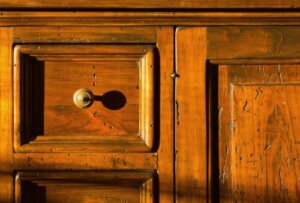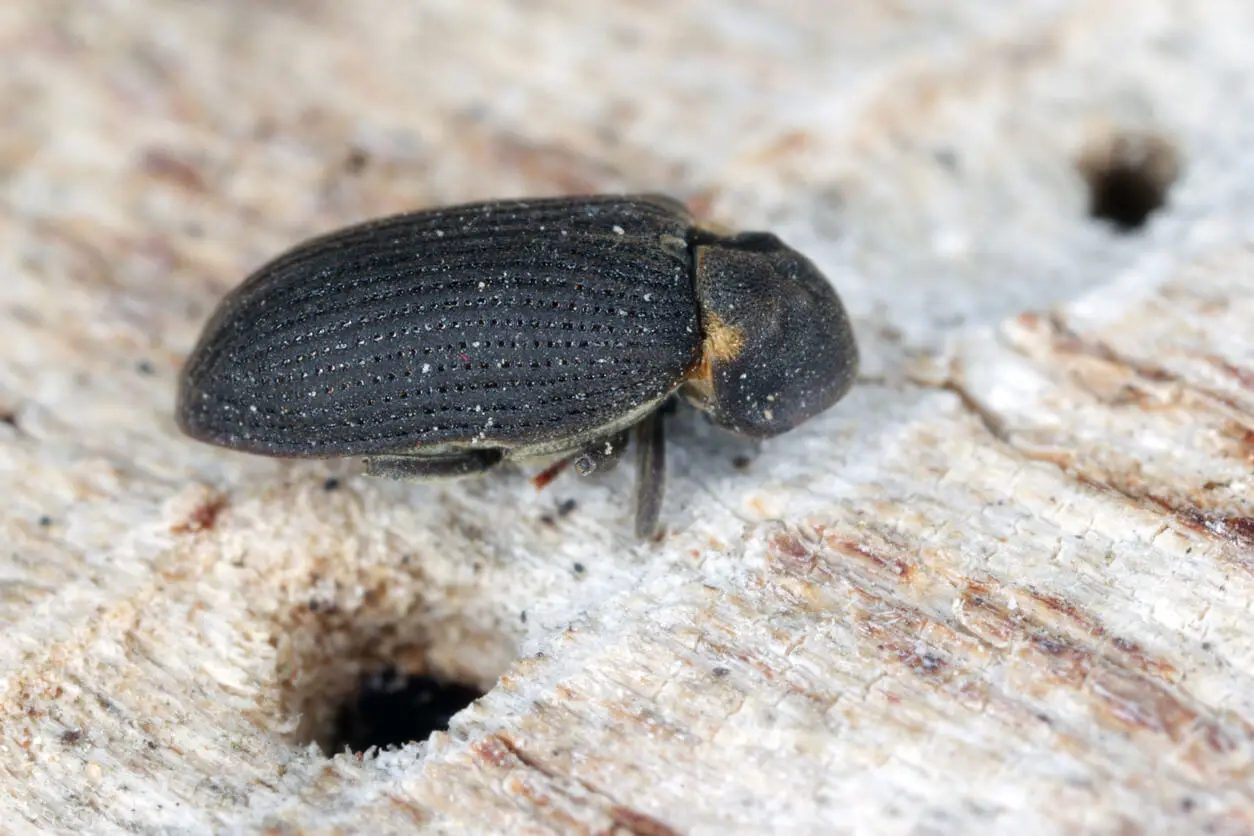Treatments to Eliminate Woodworms From Your Furniture

Woodworm infestations reach the inside of furniture and, if you don’t act quickly, they’re tough to eliminate. In general, this type of insect feeds on middle-aged wood, so it avoids very old or very new objects.
If only one piece of furniture is infested and doesn’t get proper attention in time, you increase the chances of larvae expansion and you risk losing the furniture. To prevent this from happening, we’re going to tell you how to locate the source of contamination and eliminate it successfully.
What are woodworms and why do they attack furniture?
Woodworm is a type of beetle belonging to the Coleopteran family. It falls into the category of xylophagous insects because it feeds on wood.
As pointed out in the Revista Ibero Diversidad Etimológica, these are species that, in some way, induce great losses in agricultural and forestry resources. To a lesser extent, they’re also linked to health conditions, such as contact dermatitis. Woodworm has compounds called cantharidin and pederin, which are released through legs and antennae.
When the beetle is large, it goes by the scientific name Hylotrupes bajulus. According to research reported by Cellulose, these insects are capable of degrading cellulose and hemicellulose in wood, as they find the food they need there. This is the reason why they stalk furniture made with this material.
If the beetle is small, it’s identified as Anobium punctatum or “woodworm”, popular in the United Kingdom for representing the main cause of damage to the wood in the last 100 years, as reported by The Building Conservation. On the same subject, the magazine Bosque comments that Coleoptera are a serious problem for wooden constructions since they weaken the structure and spoil the aesthetics.
The developed insect eats the external area, but there are larvae that inhabit the ducts and feed while they dig.

Learn how to detect woodworms so you can eliminate it
Woodworms indeed make noises while chewing, but this crunching is almost imperceptible. That’s why it’s a good idea to put in practice other detection techniques, as well.
The process starts from the suspicion when observing the change of aspects in the furniture. If you notice holes of greater density, traces of dust, or sawdust, there may be larvae.
To check for their presence, penetrate the opening with a needle. When the needle can be embedded smoothly, that means that there isn’t a woodworm, since they burrow parallel to the surface, forming a shallow angle that would prevent the passage of a pin.
We think you may be interested in reading this, too: Foolproof Tricks to Remove Candle Wax from Clothes, Floors and Furniture
Tips for eliminating woodworm from your furniture
Upon determining that the deterioration of furniture stems from a woodworm attack, you need to combat it immediately. Make sure to apply these remedies and techniques right away.
Clean the area with vinegar
Vinegar is the quintessential cure for removing woodworms from furniture. The magazine Maderas, Ciencia y Tecnología demonstrated in an experiment the protective capacity of vinegar as a pesticide and antifungal on wood materials.
The research consisted of placing larvae of H. bajulus in samples of Scots pine impregnated with wood vinegar in different concentrations. After 16 weeks they evaluated the mortality rates and the result indicated that the substance could be considered as an effective pesticide for woodworm grubs.
From there, the ideal method to use the treatment is to complement it with other remedies. That is to say, if you apply a commercial insecticide, at the end, you also pour some vinegar.
It’s also feasible to unite in a container enough vinegar and 2 large spoonfuls of alcohol. Soak the furniture with a brush, emphasizing the corners. An injector with the mixture is useful in the holes left by the beetles.
Blow hot air on it
Dry wood is not the woodworm’s favorite, so a way to eliminate it is to activate the highest temperature of a hair dryer and let the air seep into the holes of the furniture. An extra tip is to put a plastic sheet over the piece for a while so that the trapped heat does not give the insect any respite.
Leave the furniture out in the cold
Just as high temperatures act against beetles, low temperatures do the same. Take advantage of frost to take the furniture out into the yard and “freeze” the larvae.
Cover with plastic and leave the furniture outdoors for a couple of days. This way, the larvae will not survive. The next step is to clean and spray vinegar.
Repeating the procedure three days in a row, ending each day by wrapping the furniture in plastic wrap, would enhance the elimination of the larvae.
Inject commercial treatments
There are commercial substances that you spray or inject into the holes made by the woodworm. After administering the product, you then wrap the furniture in plastic for three weeks, so the concentrated chemical takes effect.
Use turpentine and tea tree oil
Experiments to determine remedies against devouring pests refer to turpentine as an effective option. For example, the article Turpentine and insect repellents speaks specifically of this resin-derived compound and pine oil as a deterrent to boring larvae.
The Australian Journal of Entomology lists the natural active ingredients of Melaleuca essential oil or tea tree as a safe repellent. In the same order, Recent Advances in Biology and Medicine allude to research in which this plant demonstrated antifungal, antimicrobial, and insect-repellent properties.
To combat woodworm, you mix tea tree oil with 200 milliliters of turpentine, fill a syringe with the preparation, and inject the contents into the holes scratched by the larvae. If there is any leftover, use it to spray the furniture or dampen it with a brush.

Like this article? You may also like to read: 7 Ideas for Decorating a Living Room with Dark Furniture
What to do to eliminate woodworms from furniture if the piece is very delicate or the damage is severe?
There is furniture with delicate finishes that don’t take well to sprays or applications of ecological and commercial insecticides. In turn, some infestations exceed what a commercial product could do to them.
In these scenarios, it’s a good idea to seek professional help.
The experts’ procedure includes moving the piece to a room with a low temperature because woodworms can’t tolerate extreme cold. Then, it receives substances that are toxic to the beetle. If the furniture is removable, it’s disinfected in parts.
A last suggestion is to clean and restore the furniture after the treatments. This involves adding a coat of gloss to bring it back to its original appearance.
All cited sources were thoroughly reviewed by our team to ensure their quality, reliability, currency, and validity. The bibliography of this article was considered reliable and of academic or scientific accuracy.
- Akcay, C., Yalcin, M. (2021). Análisis morfológico y químico de la madera dañada por larvas de Hylotrupes bajulus (antiguo barrenador doméstico) y su caracterización FTIR. Celulosa 28(3), 1295–1310. https://link.springer.com/article/10.1007/s10570-020-03633-5
- Akkuş, Memiş, Akçay, Çağlar, & Yalçın, Mesut. (2022). Antifungal and larvicidal effects of wood vinegar on wood-destroying fungi and insects. Maderas. Ciencia y tecnología, 24, 37. https://dx.doi.org/10.4067/s0718-221×2022000100437
- Alonso Zaragaza, M. (2015). Orden Coleoptera. Revista Ibero Diversidad Etimológica – SEA. 5, 1–18. http://sea-entomologia.org/IDE@/revista_55.pdf
- Bin, M., Ahmad, M., Aslam, M., Mamat, A. (2016). Propiedades repelentes de insectos de Melaleuca alternifolia. Avances Recientes en Biología y Medicina, 2: 57-61. https://www.researchgate.net/publication/305982253_Insect_Repellent_Properties_of_Melaleuca_alternifolia
- Buchanan, S. (2011). Turpentine and insect repellents. 121. 16-18. https://www.researchgate.net/publication/295164085_Turpentine_and_insect_repellents
- Greive, K.A., Staton, J.A., Miller, P.F., Peters, B.A. and Oppenheim, V.M.J. (2010). Desarrollo de aceites de Melaleuca como repelentes de insectos personales efectivos de base natural. Revista Australiana de Entomología, 49, 40-48. https://doi.org/10.1111/j.1440-6055.2009.00736.x
- Hutton, T. (2008). Carcoma Anobium punctatum. The Building Conservation Directory. https://www.buildingconservation.com/articles/woodworm/woodworm.htm
- Macías Alonso, B., Rodríguez Castellano, M. (2019). Dermatitis de contacto por Paederus. Dermatología Revista Mexicana, 63(4): 402-406. https://dermatologiarevistamexicana.org.mx/article/dermatitis-de-contacto-por-paederus/
- Parc de Salut Barcelona. Cantaridina. Parc de Salud Barcelona. https://www.parcdesalutmar.cat/es/dermatologia/cures-tractaments/cantaridina/
- Rebolledo R., R., Sáez B., P., Klein K., C., Salas E., C., & Aguilera P., A. (2006). Daños en casas de madera ocasionados por coleópteros xilófagos, IX Región, Chile. Bosque, 27(1), 52–56. https://www.mendeley.com/catalogue/379a17d9-7a3e-398b-824e-c19cd19a17e7/?
This text is provided for informational purposes only and does not replace consultation with a professional. If in doubt, consult your specialist.








